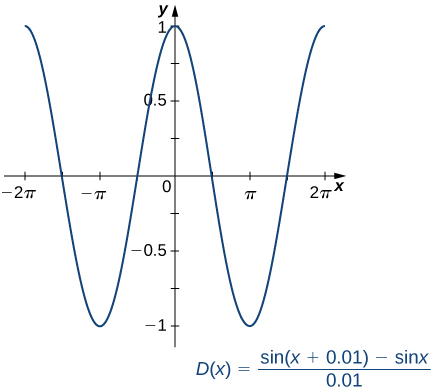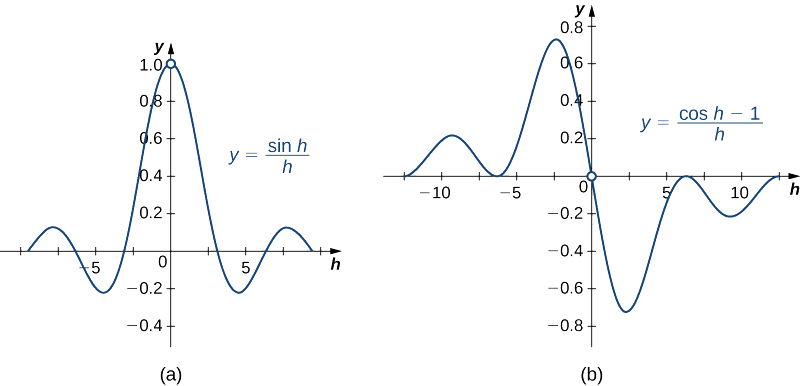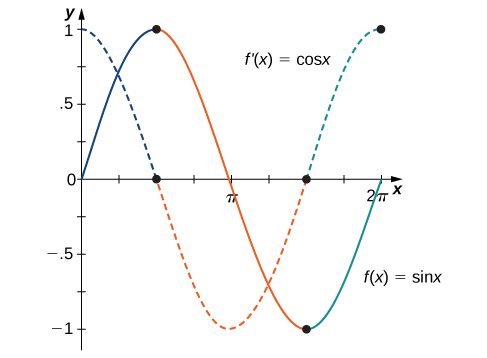

One of the most important types of motion in physics is simple harmonic motion, which is associated with such systems as an object with mass oscillating on a spring. Simple harmonic motion can be described by using either sine or cosine functions. In this section we expand our knowledge of derivative formulas to include derivatives of these and other trigonometric functions. We begin with the derivatives of the sine and cosine functions and then use them to obtain formulas for the derivatives of the remaining four trigonometric functions. Being able to calculate the derivatives of the sine and cosine functions will enable us to find the velocity and acceleration of simple harmonic motion.
We begin our exploration of the derivative for the sine function by using the formula to make a reasonable guess at its derivative. Recall that for a function \(f(x),\)
Consequently, for values of \(h\) very close to \(0\),
We see that by using \(h=0.01\),
and using a graphing utility, we can get a graph of an approximation to the derivative of \(\sin x\) (Figure \(\PageIndex\)).

Upon inspection, the graph of \(D(x)\) appears to be very close to the graph of the cosine function. Indeed, we will show that
\[\dfrac(\sin x)=\cos x. \nonumber \]
If we were to follow the same steps to approximate the derivative of the cosine function, we would find that
\[\dfrac(\cos x)=−\sin x. \nonumber \]
The derivative of the sine function is the cosine and the derivative of the cosine function is the negative sine.
Because the proofs for \(\frac(\sin x)=\cos x\) and \(\frac(\cos x)=−\sin x\) use similar techniques, we provide only the proof for \(\frac(\sin x)=\cos x\). Before beginning, recall two important trigonometric limits:\[\displaystyle \lim_\dfrac=1 \quad \text \quad \displaystyle \lim_\dfrac=0.\nonumber\]The graphs of \(y=\frac\) and \(y=\frac\) are shown in Figure \(\PageIndex\) .

We also recall the following trigonometric identity for the sine of the sum of two angles:\[\sin (x+h)=\sin x\cos h+\cos x\sin h. \nonumber \]Now that we have gathered all the necessary equations and identities, we proceed with the proof.\[\begin
\dfrac(\sin x) & = & \displaystyle \lim_\dfrac & \left( \text \right) \\
& = & \displaystyle \lim_\dfrac & \left( \text \right) \\
& = & \displaystyle \lim_\left(\dfrac+\dfrac\right) & \left( \text \right) \\
& = & \displaystyle \lim_\left(\sin x\left(\dfrac\right)+(\cos x)\left(\dfrac\right)\right) & \left( \text\sin x\text< and >\cos x \right) \\
& = & (\sin x)\lim_\left(\dfrac\right)+(\cos x)\lim_\left(\dfrac\right) & \left( \text\sin x\text< and >\cos x \text < out of limits.>\right) \\
& = & (\sin x)(0)+(\cos x)(1) & \left( \text \right) \\
& = & \cos x & \\
\end \nonumber \]
Figure \(\PageIndex\) shows the relationship between the graph of \(f(x)=\sin x\) and its derivative \(f^<\prime>(x)=\cos x\). Notice that at the points where \(f(x)=\sin x\) has a horizontal tangent, its derivative \(f^<\prime>(x)=\cos x\) takes on the value zero. We also see that where f\((x)=\sin x\) is increasing, \(f^<\prime>(x)=\cos x>0\) and where \(f(x)=\sin x\) is decreasing, \(f^<\prime>(x)=\cos x

Find the derivative of \(f(x)=5x^3\sin x\).
Using the Product Rule, we have
\[ \begin
f^<\prime>(x) & = & \dfrac(5x^3) \cdot \sin x+\dfrac(\sin x) \cdot 5x^3 \\
& = & 15x^2 \cdot \sin x+\cos x \cdot 5x^3. \\
\end\nonumber\]
After simplifying, we obtain
\[f^<\prime>(x)=15x^2\sin x+5x^3\cos x. \nonumber \]
Find the derivative of \(f(x)=\sin x\cos x.\)
Hint
Don’t forget to use the Product Rule.
Answer
Find the derivative of \(g(x)=\frac\).
By applying the Quotient Rule, we have
Simplifying, we obtain
Find the derivative of \(f(x)=\frac\).
Use the Quotient Rule.
Answer
A particle moves along a coordinate axis in such a way that its position at time \(t\) is given by \(s(t)=2\sin t−t\) for \(0 \leq t \leq 2 \pi .\) At what times is the particle at rest?
To determine when the particle is at rest, set \(s^<\prime>(t)=v(t)=0.\) Begin by finding \(s^<\prime>(t).\) We obtain
so we must solve
\[2 \cos t−1=0\text< for >0 \leq t \leq 2 \pi . \nonumber \]
The solutions to this equation are \(t=\frac< \pi >\) and \(t=\frac\). Thus the particle is at rest at times \(t=\frac< \pi >\) and \(t=\frac\).
A particle moves along a coordinate axis. Its position at time \(t\) is given by \(s(t)=\sqrtt+2\cos t\) for \(0 \leq t \leq 2 \pi .\) At what times is the particle at rest?
Hint
Use the previous example as a guide.
Answer
Since the remaining four trigonometric functions may be expressed as quotients involving sine, cosine, or both, we can use the Quotient Rule to find formulas for their derivatives.
Find the derivative of \(f(x)=\tan x.\)
Start by expressing \(\tan x \) as the quotient of \(\sin x\) and \(\cos x\):
Now apply the Quotient Rule to obtain
Simplifying, we obtain
Recognizing that \(\cos^2x+\sin^2x=1,\) by the Pythagorean Identity, we now have
Finally, use the identity \(\sec x=\frac\) to obtain
Find the derivative of \(f(x)=\cot x .\)
Hint
Rewrite \(\cot x \) as \(\frac\) and use the Quotient Rule.
Answer
The derivatives of the remaining trigonometric functions may be obtained by using similar techniques. We provide these formulas in the following theorem.
The derivatives of the remaining trigonometric functions (along with the sine and cosine) are as follows:
At this point, getting these formulas cemented in your memory as quickly and efficiently as possible is very important. The following might help a little:
The derivatives of the cosine, cosecant, and cotangent have a negative sign in their formulas (not to be construed as "they are always negative," which is not true).
Find the equation of a line tangent to the graph of \(f(x)=\cot x \) at \(x=\frac< \pi >\).
To find the equation of the tangent line, we need a point and a slope at that point. To find the point, compute
Thus the tangent line passes through the point \(\left(\frac< \pi >,1\right)\). Next, find the slope by finding the derivative of \(f(x)=\cot x \) and evaluating it at \(\frac< \pi >\):
Using the point-slope equation of the line, we obtain
Find the derivative of \(f(x)=\csc x+x\tan x .\)
To find this derivative, we must use both the Sum Rule and the Product Rule. Using the Sum Rule, we find
In the first term, \(\frac(\csc x)=−\csc x\cot x ,\) and by applying the Product Rule to the second term we obtain
\[\dfrac(x\tan x )=(1)(\tan x )+(\sec^2 x)(x).\nonumber\]
Therefore, we have
\[f^<\prime>(x)=−\csc x\cot x +\tan x +x\sec^2 x. \nonumber\]
Find the derivative of \(f(x)=2\tan x −3\cot x .\)
Hint
Use the rule for differentiating a constant multiple and the rule for differentiating a difference of two functions.
Answer
The tricky thing about trigonometric functions is the number of identities that you have and the ultimate desire to simplify your answers. It's often best to perform a few extra steps to see if any algebra or trigonometry could simplify this result further.
As you can see, our efforts to arrive at a more "simplified" form have not really paid off. Any of these answers are equivalent, and none are really "simpler" than others; however, it is always advisable to perform a few extra steps like this to see if your results simplify (they often will).
Find the slope of the line tangent to the graph of \(f(x)=\tan x \) at \(x=\frac< \pi >\).
Hint
Evaluate the derivative at \(x=\frac< \pi >\).
Answer
The higher-order derivatives of \(\sin x\) and \(\cos x\) follow a repeating pattern. By following the pattern, we can find any higher-order derivative of \(\sin x\) and \(\cos x.\)
Find the first four derivatives of \(y=\sin x.\)
Each step in the chain is straightforward:
Analysis
Once we recognize the pattern of derivatives, we can find any higher-order derivative by determining the step in the pattern to which it corresponds. For example, every fourth derivative of \(\sin x\) equals \(\sin x\), so
Hint
See the previous example.
Answer
We can see right away that for the 74th derivative of \(\sin x\), \(74=4(18)+2\), so
Hint
Answer
A particle moves along a coordinate axis in such a way that its position at time \(t\) is given by \(s(t)=2−\sin t\). Find \(v( \pi /4)\) and \(a( \pi /4)\). Compare these values and decide whether the particle is speeding up or slowing down.
Next, find \(a(t)=v^<\prime>(t)\). Thus, \(a(t)=v^<\prime>(t)=\sin t\) and we have
Since \(v\left(\frac< \pi >\right)=−\frac>\right)=\frac>>0\), we see that velocity and acceleration are acting in opposite directions; that is, the object is being accelerated in the direction opposite to the direction in which it is traveling. Consequently, the particle is slowing down.
A block attached to a spring is moving vertically. Its position at time t is given by \(s(t)=2\sin t\). Find \(v\left(\frac\right)\) and \(a\left(\frac\right)\). Compare these values and decide whether the block is speeding up or slowing down.
Hint
Use Example \(\PageIndex\) as a guide.
Answer
\(\dfrac\big(\sin x\big)=\cos x\quad\text\quad\dfrac\big(\cos x\big)=−\sin x\).